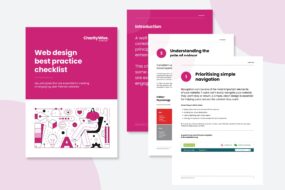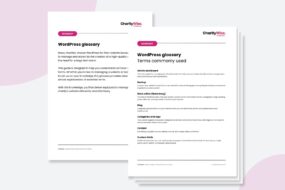

Many charities claim to be doing UX, but really this term can often be applied to an outdated design process. I am going to lay it on the line here – you can’t do UX without understanding your users.
This is an idea that has been perfectly expressed by Hoa Loranger, VP at Nielsen Norman Group, in her article, “UX without user research is not UX”.
Just so we are clear, the founders of Nielsen Norman Group, Don Norman and Jakob Nielsen, pretty much invented UX. When they started the company in 1998, they defined it as follows:
The first requirement for an exemplary user experience is to meet the exact needs of the customer, without fuss or bother. Next comes simplicity and elegance that produce products that are a joy to own, a joy to use.
I think about Dom and Jakob and the efforts they’ve made to change the world of design whenever I see digital experiences that have clearly been designed without any regard for the user. I imagine Dom and Jakob looking a bit deflated, though never angry. This is even more upsetting if you know what Dom looks like. An old colleague of mine nicknamed Dom ‘Papa UX’. Google him and you’ll understand.
Too often, experiences are designed with a focus on charity goals, fancy features, and the technological capabilities of new platforms and software. But user centred design (UCD) is a methodology that puts user needs at the centre of a product or solution.
It aims to give users a voice at the boardroom table and helps charities offer a point of distinction over their competitors while addressing the core needs of their supporters and beneficiaries.
Please don’t think that UCD means ignoring your goals or objectives. It simply lets users’ needs drive a solution that delivers value to your charity.
There’s a perception that UCD is an expensive approach to design, but this doesn’t have to be the case. The process can work for a variety of budgets and scales. The most crucial part is a shift in mindset, to a place where you don’t take the voice of the loudest stakeholder as gospel but you get out there, speak to supporters and beneficiaries and discover the truth. I know this can be a daunting idea, but take those stakeholders on the journey with you and it won’t be long before they see the value of a user centred design approach.
Lets look into this in more detail
Part 1: What is user centred design?
The 3 essential ingredients
We believe user centred design (UCD) broadly breaks down into three essential ingredients:
- Understand your audience
Identify the people who may use your charity’s services, what they will use it for and the conditions under which they will use it. What are their needs, influences, feelings, actions, pain points and overall goals? - Let everyone have a voice
Define the organisational and technical requirements that must be met your service to be successful. Exemplary user centred design is where these organisational and technical needs meet the needs of your users - Create solutions iteratively
This part of the process can be done in stages, from sketching a rough concept to building a complete design. Evaluate your thinking frequently throughout the design process by testing your proposed solution on real supporters and beneficiaries of your charity
Why adopt a user centred approach?
There are many case studies of charities and other organisations successfully using UCD in their approach when creating new solutions or improving their existing ones.
Think about your favourite websites, software, products or services. Are they useful, intuitive and enjoyable to use? It’s certain they spoke to their users to craft their design and development.
A few examples of charity brands known for providing experiences focused on user needs are Macmillan, Comic Relief and Barnardo’s.
Each of these has a focus on the emotional relationship between their digital experiences and the user, instead of focusing on purely business and technology requirements.
Meta case study
Promoting connection: Designing social media experiences to support people with eating disorders.
Objective
To support users with eating disorders.
Methodology
- Used secondary research to better understand the topic and develop a list of questions for topic experts
- Conducted focus groups with topic experts to understand eating disorders and related themes
- Used one to one interviews with participants who have or have had an eating disorder
End result
- A user flow, crafted using design principles by user researchers and other UX team members, that would provide support options, meeting users where they are
- The researchers included several design team members throughout the process, which helped them move the research to design implementation

Part 2: Key advantages of UCD
Clearer requirements
Often, the requirements that a website or product needs to fulfil are created by an internal stakeholder where user needs or context are secondary. When you let user needs drive a solution that still delivers on the charity’s objectives, your requirements should be far more accurate and you’ll be heading in the right direction from day one.
Increased value per user
Creating a solution that users want or need can increase brand loyalty.
It is not uncommon for a great user experience to be the decisive factor in
a supporters decision-making process. We have spoken to many users over the years that say that if two charities share very similar goals or objectives, they will choose the one with the better user experience.
Reduced waste
Through validation, via user testing and research, you should be able to limit the risk of failure and increase your chances of success, in the form of better usability and more website conversions. This lowers your chances of wasting time, resources and materials on ideas based on unhelpful assumptions that were never going to work.
Added value to the wider charity
It is not uncommon for findings gathered during a UCD process to be shared with a wider charity. Research and user insight behind a digital project can inform a seemingly unrelated project in another area of the organisation. Proactively sharing insights across teams can be a great way of reminding everyone who your supporters and beneficiaries are and what their needs are.
Extended solution life
In theory, creating a solution that addresses user needs from day one will give your product a longer shelf life. That said, it’s important to remember that user needs are everchanging and you must continue to listen and iterate on your solution to make sure it stays relevant.
Part 3: How your charity can embrace UCD
Without a proper understanding of your users, their needs and behaviours, the design of a solution is likely to fall short of their expectations.
The discovery phase gets to the heart of what really matters to users and informs the design process, based on data and facts rather than opinions and assumptions.
Key discovery phase activities

A kick-off workshop
This is the sensible starting point for any project where an interdepartmental team of people will collaborate to create the project goals. Work with your project stakeholders to set the product vision and a framework to work within. Defining the target audience(s) and document what you already know about them.
Stakeholder interviews
Take the time to interview your stakeholders on a one to one basis, and understand their personal requirements and goals for the project. Stakeholders can be wider than just the people signing the cheques; think about who else the project will impact. For example, we find that support or advice team members are an incredibly valuable source of insight who can provide frontline experience of common issues – an invaluable resource when defining the challenge ahead.
Empathy mapping
Try using empathy maps to encourage project stakeholders to think like supporters and beneficiaries and not in an organisational centric fashion. The purpose of an empathy map is to help stakeholders externalise their knowledge in a form that assists with design decision-making and audience definitions. You can then treat the empathy maps as hypotheses, or a starting point, for any formal user research.
Data insight
Where there is an existing solution, it is key to first understand how users are interacting with it in order to improve the digital experience. An assessment of the data (quantitative assessment) is likely to be a good starting point for any project.
Remember: Data will often give you the ‘What’ but it is also important to understand the ‘Why’, and this is where user research comes into its own.
User interviews and testing
Interviewing users will help to validate or challenge the findings of your stakeholder interviews and empathy maps. Both existing users of the current website or app, and people who could be the target or potential users should be asked about their needs and experiences, to see whether these correspond to the views of stakeholders. New findings may also be uncovered, and these can feed into the solution design.
User interviews involve sitting down with people to ask questions about their behaviours and needs. They can give you a broader understanding of users and their day-to-day lives, allowing for greater empathy in your approach.
User testing involves getting people to use the website or app in order to see whether they run into any issues or experience any friction and can measure how well the product meets their needs.
User testing generally falls into three categories:
1- Remote unmoderated testing
Users undertake tasks with no supervision, in their own time from their own homes. This is often the cheapest option and can be completed through tools like usertesting.com.
2- In-person moderated testing
Users travel to a testing ‘lab’ to undertake a series of tasks given to them by a moderator.
User testing can be a hard to secure budget for, but it is the most important part of the process. It will provide insights that can set you apart from the competition and allow you to create digital experiences to be proud of.
3- Remote moderated testing
Users undertake tasks facilitated by moderator (in a different location) using a screen sharing tools like Zoom or Teams.
Good design is actually a lot harder to notice than poor design, in part because good design fits our needs so well that the design is invisible.
Don Norman, Founder of Nielsen Norman Group
Create a solution through collaboration, experimentation and validation.
Try to use a blended team of key stakeholders, designers and developers to create early design solutions.
This will allow you to create outcomes that will meet both user and charity needs without investing too much time in a direction that will ultimately fail. By using rapid prototypes, you can prove your theories and ideas before committing to a final design.
Like in the discovery phase, user testing is a crucial part of the design process and should be used to validate early design decisions. When combined with the user testing findings from the initial discovery phase, user testing your designs creates a valuable feedback loop which can help you iterate towards an optimal solution for your supporters and beneficiaries.

Part 4: How to move towards UCD excellence
The five step Experience Success Ladder
This framework was developed by Ward Andrews of Drawbackwards. It is designed to help lead your charity towards UCD excellence.
Each level represents a higher state of user satisfaction, always working towards
creating meaningful value for your supporters and beneficiaries. By moving up from one level to the next, you’re not only better meeting your users’ needs, but also increasing your charity’s chances of success.

Level 1 – Functional
There are lots of ‘functional’ experiences out there that simply get the job done.
But just because you can technically complete a task, it doesn’t mean the product or service is as usable as it can be. Many products and services have trouble moving beyond the functional rung of the ladder. This is often due to solutions not being based on user needs. Instead, they are often engineering- or development-driven, and heavily influenced by internal preferences and politics.
This can lead to several problems for both users and organisations, for example:
- Users feel lost and discouraged, resulting in dissatisfaction and abandonment
- Charities waste time and budget on solutions that don’t meet user needs
- Charities lose out on opportunities to better serve their supporters and beneficiaries and gain market success
Level 2 – Usable
Overcoming usability issues and climbing to the next level requires taking a step back and identifying ways to make your product or service more intuitive for users.
Usable products and experiences go a bit further than functional ones in that they take into account user experience, but they aren’t designed with your actual end users in mind.
They also:
- Have some solid design patterns, but they aren’t baked into every part of the user journey
- Are often designed based on the hunches and generic design principles of internal teams and stakeholders, not end users’ needs
- May allow users to accomplish tasks, but cause frustration and friction
Level 3 – Comfortable
Experiences that are functional and usable might get initial success and provide enough financial support to survive for a while . But unless the experience is comfortable, it doesn’t stand much of a chance of greater, long-term success.
Comfortable experiences are intuitive and familiar. They just feel right. Their sense of flow makes it easy for users to move from one task to another and seamlessly accomplish their goal. These often come about when a charity adopts a user centred design process, doing usability research and making decisions based on what is best for the user.
By providing a comfortable experience, your charity will start to:
- Receive higher satisfaction score
- Increase financial support
- Build a loyal base of fans
- Save users time and brainpower
- Become a ‘go-to’ for users
Level 4 – Delightful
Once your product or service moves past being functional, usable and comfortable, you will start to see a design maturity that will set the scene for creating delightful experiences.
These go beyond helping users accomplish tasks intuitively. They actually make
it fun and enjoyable. Whether it is through interesting animations, secret features
or unlocking exciting added extras, small moments of surprise and delight lead
to happiness, connection and potential diehard fandom.
With a delightful experience, you should start to see return on investment on putting much more time and effort into design.
This could lead to:
- A spike in KPIs
- Increased positive user feedback
- A committed following of users
- Passion for your charity that start to turn your users into advocates
Level 5 – Meaningful
Many charities are on the quest to make their users’ lives a little easier and happier, but very few reach the Holy Grail of being meaningful.
Meaningful experiences are more than just functional, usable, comfortable, and delightful. They change the user’s life and create long-lasting success for the charity.
Although this level is difficult to reach, having a meaningful experience could see your charity benefiting from:
- Advocates who tell everyone to support the work you are doing
- The highest review scores in your category
- Fewer complaints and more forgiveness, due to their affinity with your brand and digital experiences
- Strong financial support that grows over time and weathers economic downturns
The biggest success stories are those who transform purely functional products and services into delightful experiences that add meaning to users’ lives. Whether these charities thought of this process as a ladder, mountain or roadmap, they always focused on user needs as a guiding light for their solution.
Part 5: Putting it all together
Placing your users at the heart of your digital experiences is of benefit both to them and to your charity.
When you understand your audience, you can meet their needs, creating
a solution that is simple and joyful to use.
It all starts with the discovery phase; learning as much as you can about your real users through research and testing. Make sure you give all internal and external stakeholders a voice during this process, then create iterative designs to test as you go.
When it’s done well, user centred design can lead to the kinds of meaningful experiences Ward Andrews talks about. Without exaggeration, these meaningful experiences can change your users’ lives, turning them into advocates and supporters of your charity.
The tangible benefits to your organisation can include clearer requirements for your solution, increased value per user, more financial support and better brand loyalty. You will waste less time on designs that aren’t delightful and meaningful, and extend the life of your solution.
User centred design is for every organisation, whether you are a smaller with a budget to match, or a national or multinational charity. Whatever your available spend and resources, there is a version of this process that can work for you.




